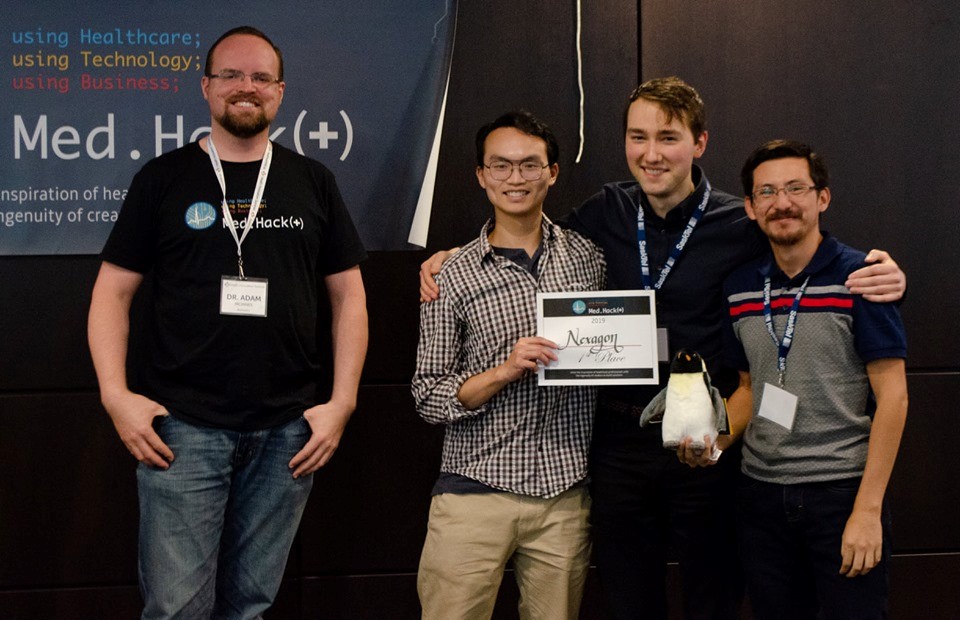
Finding a concussion hack in 48 hours
University of Saskatchewan (USask) medical students Richard Ngo and Brandon Spink teamed up with biomedical and mechanical engineering students to win a 48-hour hackathon with their invention that could prevent concussions in sports.
By Richard NgoMedicine is about collaboration, not just between health professionals, but with other professions.
One career path I envision myself taking is to be a medical consult in the building of medical devices/inventions. Working with engineering, computer science, and business students at Med.Hack provided a great experience for what I would like to do in the future.
Med.Hack(+) is an event designed to solve problems in healthcare through the use of technology. At the hackathon, we brainstorm ideas, form teams, and prototype solutions to real-life issues over the course of 48 hours. This year’s event took place in Saskatoon from Oct. 4-6.
I had seen posters of Med.Hack all around campus, but at the time, I did not know what it involved, nor that it was open to medical students. I learned more about Med.Hack through talking with my friend, who is a computer science student, and he suggested it was something I would be interested in.
At Med.Hack, presenters posed healthcare problems that they wish to solve. Dr. Sean Maw (an engineering professor at the University of Saskatchewan) posed the problem of concussions in sports.
The next day, people formed groups of which problems they wanted to work on. Fellow medical student Brandon Spink and I teamed up with Andres Erazo, who is a current PhD student in biomedical engineering at USask, along with his friend Gabriel, a mechanical engineering student at the Universidad de las Fuerzas Armadas in Ecuador, who aided us in creating computer simulations of our model.
Our solution was a neck brace that dampens the movements of the head.
The Nexagon is a project designed to reduce the rotational forces exerted on the head from a whiplash-related event in order to prevent concussions. This can be achieved by applying a dampening effect which could reduce the velocity of rotation produced by the head and neck, and the peak force generated. This prevents the brain from violently shaking inside the skull and reduces damage to soft tissue.
Our model uses a polymer-based material which follows an elastic hexagonal subunit design that encloses the neck. Currently, we are working towards building a prototype that can dampen the rotational velocities which leads to a concussive event. This would mitigate the consequences of a whip-lash related injury.
We placed first in the 2019 Med.Hack with our Nexagon invention based on the judges’ decision on who had the best invention out of the competing groups. In addition, we also won the First Penguin Award which was given to the group who tried to tackle a problem using an innovative approach.
Brandon also recalls an interesting idea from Adam McInnes (founder of Med.Hack) that has stuck with us since the competition.
“McInnes mentioned to us that medical innovations happen when interdisciplinary disciplines and ideas intersect. This is known as the Medici effect.”
Our first place prize is to present our Nexagon device at the Ward of the 21st Century (W21C) Innovation Academy on Oct. 30 at the University of Calgary. W21C is a healthcare systems research and innovation initiative based in the University of Calgary’s O’Brien Institute for Public Health, and the Calgary Zone of Alberta Health Services (AHS). W21C serves as a research and beta test-site for exemplary hospital design, novel approaches to health care delivery, human factors research, and innovative medical technologies.
We will not be part of the competing teams at the W21C but rather we will attend the pitch competition as an exhibition team, but with all the rights and privileges afforded to the competing teams. They will give us our own booth to demo our Nexagon prototype and we will have a poster to present the research behind the Nexagon. This conference will give us the opportunity to network and receive feedback from internationally renowned health innovators.
Technology such as artificial intelligence, will only continue to advance in medicine. Sooner or later, we will have to learn what are the benefits and limitations of using these technologies in our practice. Learning how to talk and collaborate with computer scientists and engineers is a good place to start with understanding how this medical technology works.
If you have an interest in learning about medical entrepreneurship, technology, and designing medical devices, competitions such as Med.Hack are a great starting point.
